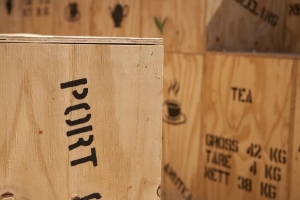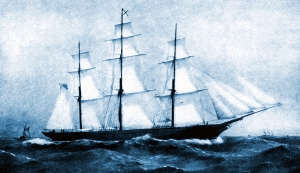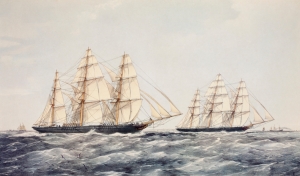A Brief History
Discover the ancient origins and fascinating history of tea!
This section covers the development and use of the Clipper ships to carry the cargo's of tea from the India and China to the UK and America.
The age of the tea clippers lasted only two decades, but this brief reign was marked by such excitement and enthusiasm for the ships and their cargo that it has gone down in history, famed for its glamour and romance.
the average East Indiaman could carry 1,200 tons of cargo
During the seventeenth and eighteenth centuries, the East India Company had the monopoly on British trade with China and India.Because no other company could legally import goods from these countries, the Company was rarely in a hurry to transport its merchandise. Rather, its priority was to minimise costs by carrying as much as possible on each ship. This meant that its ships - known as East Indiamen - were enormous, strong and very slow. By 1800, the average East Indiaman could carry 1,200 tons of cargo. The trading pattern for China tea usually meant the East Indiamen set sail from Britain in January, sailed round the Cape of Good Hope at the southern-most tip of Africa and arrived in China in September.
the round trip took almost two years,
They would load up that year's tea harvest and set off again, and depending on the wind and weather, aim to arrive back in Britain by the following September. So even with favourable sailing conditions, the round trip took almost two years, and if anything went wrong it could take a lot longer.
 But by 1834 the Company had lost its trading monopolies, and tea and had become a freely traded item. The Company, having no more use for its great ships, sold them off, and many were bought by merchants or their captains, who continued to plough the seas between Britain and China plying the tea trade. But now that tea could be traded freely, a few canny sailors began to realise that whoever brought the tea from each new harvest to Britain first stood to make the most money.
But by 1834 the Company had lost its trading monopolies, and tea and had become a freely traded item. The Company, having no more use for its great ships, sold them off, and many were bought by merchants or their captains, who continued to plough the seas between Britain and China plying the tea trade. But now that tea could be traded freely, a few canny sailors began to realise that whoever brought the tea from each new harvest to Britain first stood to make the most money.
it was the Americans who pioneered the first clipper ships
This was partly because of practicalities - if you were home first, you could sell your shipment of tea before your competitors even arrived - and partly because consumers in the nineteenth century believed that the fresher and earlier-picked the tea, the better the resulting drink. The lumbering East Indiamen seemed less appealing, and tea traders wanted faster, sleeker ships to bring their precious cargo back. Nonetheless, this idea only caught on in Britain slowly, and while the 1840s saw a few faster ships launched, for the time being many merchants remained satisfied with the slow but reliable East Indiamen.
In fact it was the Americans who pioneered the first clipper ships. Based on an earlier type of ship called the Baltimore clipper, they were fast and slender, with a narrow hull that was deeper at the back than at the front, and acres of sails on tall masts. Some had as many as six tiers of sails to a mast, and a total of 35 sails. They earned their name from the way that they 'clipped off' the miles.
earned their name from the way that they 'clipped off' the miles
The first true tea clipper was Rainbow, designed by John W. Griffiths and launched in 1845. She made the journey from New York to Canton in 102 days - taking more than two weeks off the previous record for that trip. Their development was given another boost by the discovery of gold in California in 1848 and in Australia in 1851 - people rushing to seek their fortunes wanted ships that would transport them as fast as possible.
Up until 1849 the use of clippers in the tea trade was largely confined to America. But in 1849 the British Navigation Laws were repealed, meaning that American ships were allowed to carry tea from China to Britain for the first time. The first clipper to take advantage of this was Oriental, which arrived at West India Dock in London on 3 December 1850 - just 97 days after leaving Hong Kong. British merchants were horrified - this was three times as fast as the East Indiamen. They resolved to build their own clippers to rival the Americans, and the first British tea clipper, Stornaway, was built in Aberdeen in 1850.
three times as fast as the East Indiamen
After this, tea clippers were designed and built in Britain throughout the 1850s and 1860s; they had a narrower beam than their American equivalents, making them less powerful in heavy weather, but faster in lighter winds. There was a great spirit of competition between the British and American ships plying the tea trade, but to begin with the Americans had the edge. Then in 1851 the British ship owner Richard Green announced that he was fed up with hearing about the dismal prospects for British shipping since the repeal of the Navigation Laws, and built the aptly named clipper Challenger, with the stated intention of beating the American ships. Leaving Canton for London in 1852 loaded with tea, she fell in with the American clipper Challenge, a much larger, older ship, already greatly admired for her speed. Large sums were bet on which would make it to London first, and in the event the British Challenger beat Challenge to the docks by two days, amid much jubilation about the British success.
 The time of the international races was relatively short lived though, because after 1855 the American ships gradually ceased to participate in the English tea trade. But even without the Anglo-American rivalry, the competitive spirit continued. It was really ignited in 1853, when new ports in China were opened up for trade. These included Fouchow, which was much closer to the tea producing areas than Canton, the port used previously. As a result the tea could be loaded onboard earlier and fresher, and the clippers could set off in late May or early June - sometimes not even taking time to complete the official paperwork - racing back to Britain come hell or high water.
The time of the international races was relatively short lived though, because after 1855 the American ships gradually ceased to participate in the English tea trade. But even without the Anglo-American rivalry, the competitive spirit continued. It was really ignited in 1853, when new ports in China were opened up for trade. These included Fouchow, which was much closer to the tea producing areas than Canton, the port used previously. As a result the tea could be loaded onboard earlier and fresher, and the clippers could set off in late May or early June - sometimes not even taking time to complete the official paperwork - racing back to Britain come hell or high water.
cargo of the winning ship could earn a premium of up to sixpence per lb
They thundered down through the South China Sea and into the Indian Ocean, then raced to round the southern-most tip of Africa at the Cape of Good Hope. Then it was north across the vast Atlantic, past the Azores, through the English Channel and into the Thames estuary, from where they would be towed down the Thames by tugs.
The cargo of the winning ship could earn a premium of up to sixpence per lb - and so the captain and crew were rewarded by the owners of the cargo.But the races were about more than just financial gain: the crews, about 40 men on each clipper, were expert sailors, proud of their ships, who delighted in competing against each other. Without their enthusiasm the races would never have happened, since getting the ship home as fast as possible required complete dedication from the crew, who sacrificed rest for the excitement of the race. The lively rivalry between crews is exemplified in the story of a gilded model cockerel which was exhibited on the clipper Thermopylae. Other clipper crews took this as an affront, because at the time Thermopylae had yet to win a clipper race. One night at the harbour in Fouchow, when her officers and crew were below, a sailor from the rival clipper Taiping jumped overboard, swam across to Thermopylae, climbed aboard and stole the cockerel. Discovering their loss, the crew of the Thermopylae was furious, and there were a number of angry (and even violent) incidents between them and rival crews.
telegrams would be despatched to Britain with news of their progress
The clipper races quickly caught the public's imagination - the speed and rivalry were thrilling while the ships themselves were as beautiful as they were fast. The ships would sail past certain marker points, and then telegrams would be despatched to Britain with news of their progress. When the time for the arrival of the first clippers grew near, the race would be a central topic of conversation, and crowds gathered at the docks to watch the arrival of the ships (the masts and bulwarks of which were all painted differently, to make the ships distinguishable from each other), greeting the winner with great cheers. Such was the public enthusiasm for the clipper races that large amounts of money were bet on which ship would be home first.
Image: The British tea clipper ship (windjammer) LAHLOO built by Robert Steele and & company at Greenock, Scotland in 1867. Image available here
 The greatest and most famous clipper race took pace in 1866. 10 clippers bound for London set out from Fouchow on 28 May. Fastest away were Taeping, Fiery Cross and Serica, but Ariel swiftly gained on them. So evenly matched were these four ships and their crews that the clippers were frequently within sight of each other as they raced across the Indian Ocean, round the Cape of Good Hope and north across the great Atlantic.
The greatest and most famous clipper race took pace in 1866. 10 clippers bound for London set out from Fouchow on 28 May. Fastest away were Taeping, Fiery Cross and Serica, but Ariel swiftly gained on them. So evenly matched were these four ships and their crews that the clippers were frequently within sight of each other as they raced across the Indian Ocean, round the Cape of Good Hope and north across the great Atlantic.
huge sums had been bet on the ships
On 29 August the four were dead level at the Azores, but as they entered the Channel Ariel and the Taeping pulled away, the ships magnificent in full sail.
Practically the entire population of London was electrified by the news of the race - huge sums had been bet on the ships, while the crews of Fiery Cross and Serica had wagered a month's pay against each other - and the merchants and dealers on Mincing Lane, the centre of the London tea trade, were beside themselves with excitement. At the Thames estuary the two ships were still neck and neck, but tugs were needed to tow the ships down the river to dock, and Taeping was fortunate enough to pick a faster tug. With this slender advantage Taeping reached her berth just 20 minutes ahead of Ariel - an amazingly small gap considering the journey had taken 99 days. (Almost as amazing - Serica docked just a few hours after the winning pair, on the same tide, and Fiery Cross less than 48 hours later.) Despite Taeping's tiny lead, in the spirit of sportsmanship the race was declared a dead-heat, and the ships' owners agreed to divide the winner's premium, while the two crews shared their bonus.
Image The tea clippers Taeping (left) and Ariel (right) in The Great Tea Race of 1866, from China to London. After a passage of 14,000 miles the Taeping won, docking in London less than half an hour before the Ariel. Image available here
Of course, life on the tea clippers was not just about the excitement of racing and the glamour of being the first ship home. There was serious work to be done onboard, and loading the tea was an art form in itself. The cargo needed to be packed incredibly tightly, not just to carry as much tea as possible, but also to prevent the potential hazard of the cargo shifting as the ship sailed, which could have thrown the ship off balance and caused disaster. The Chinese dockers packed the chests in tiers, sometimes hammering them into place with great wooden mallets. It was skilled work carried out at great speed, and equally skilled were the English dockers whose job it was to unload the cargo at the other end of the journey.
The reign of the tea clippers was to prove as brief as it was glorious. In November 1869 the Suez Canal opened, creating a navigable passage between the Far East and the Mediterranean. Overnight, it became economically viable for steamships to ply the China tea trade. Previously, the amount of coal the steamers needed to carry to complete the journey to and from China round the Cape of Good Hope left little space for a bulky cargo like tea. But sailing via the Suez Canal, the journey length was cut dramatically and the steamships became a more efficient option than the clippers, which could not use the Canal. The plodding steamships had none of the glamour of the clippers and their brave and skilled crews, and while there was rivalry between the steamers, it never caught gripped the public imagination like the clipper races.
the clippers could not use the Canal
Happily, one great tea clipper has survived and is now in dry dock at Greenwich in London. Cutty Sark, launched from the Clyde on 22 November 1869, was one of the last tea clippers to be constructed. Built for John 'White Hat' Willis, she was intended to win the annual clipper race, although in fact she never beat her biggest rival, Thermopylae. The decline of the clipper tea trade meant that Cutty Sark only carried tea until 1877, but she survived many later incarnations, and is now the only remaining tea clipper in the world. Small to modern eyes, Cutty Sark is nonetheless breathtakingly beautiful, and a visit offers a fascinating insight into the life of a tea clipper.